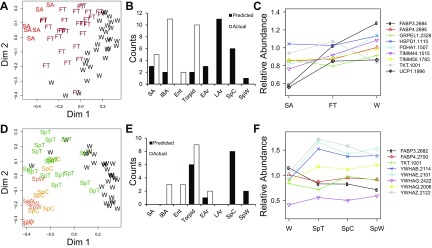Fig. 7.
Classification of fall and spring transition animals. Ground squirrels representing mixed physiology transition timepoints had proteomes generally intermediate to their flanking seasons. The overall proximity of transition animals (A: fall, D: spring) to flanking states (SA or SpC/SpW and winter individuals, “W”) was determined by unsupervised classification in Random Forests, using the top 30 inputs from physiologically known individuals. Counts (B: fall, E: spring) of the single most proximate state for each individual (predicted from a Random Forests training set of all base state animals) are compared with their actual physiology as measured by Tb at time of tissue collection. “Torpid” is most analogous, but not identical, to LT because, although transition animals were torpid at the time of tissue collection, Tb, Ta, and the time in torpor varied (see Fig. 1). The transition of several proteins of interest are presented by line plots (C: fall, F: spring).

